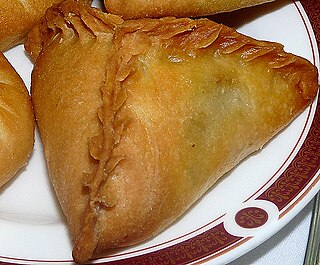 W
WBashkir cuisine is the traditional cuisine of the Bashkirs. Their way of life, and the predominance of cattle breeding contributed culture, traditions, and cuisine of the Bashkirs.
 W
WBeshbarmak is the national dish among nomadic Turkic peoples in Central Asia and Russia. It is also known as naryn in Xinjiang, Uzbekistan, Kyrgyzstan and Kazakhstan, as turama or dograma in Karakalpakstan, North Caucasus and Turkmenistan, and as kullama in Bashkortostan and Tatarstan.
 W
WBoortsog or bawïrsaq is a type of fried dough food found in the cuisines of Central Asia, Idel-Ural, Mongolia and the Middle East. It is shaped into either triangles or sometimes spheres. The dough consists of flour, yeast, milk, eggs, margarine, salt, sugar, and fat. Tajik boortsog are often decorated with a criss-cross pattern by pressing the bottom of a small strainer on the dough before it is fried.
 W
WÇäkçäk, frequently anglicized as chak-chak, is a Tatar sweet. It is particularly popular in Tatarstan and Bashkortostan, and is recognized as Tatarstan's national sweet in Russia.
 W
WKashk is a range of dairy products used in cuisines of Iranian, Afghan, Turkish, Mongolian, Central Asian, Transcaucasian and the Levantine people. Kashk is made from drained yogurt or drained sour milk by shaping it and letting it dry. It can be made in a variety of forms, like rolled into balls, sliced into strips, and formed into chunks.
 W
WKumis is a fermented dairy product traditionally made from mare's milk or donkey milk. The drink remains important to the peoples of the Central Asian steppes, of Huno-Bulgar, Turkic and Mongol origin: Kazakhs, Bashkirs, Kalmyks, Kyrgyz, Mongols, and Yakuts. Kumis was historically consumed by the Khitan, Jurchen, Hungarians and Han Chinese of North China as well.
 W
WOcpocmaq is a Tatar national and Bashkirs dish, an essential food in Tatar and Bashkirs culture. It is a triangular pastry, filled with chopped beef, onion and potatoes. Öçpoçmaq is usually eaten with bouillon or with tea.
 W
WPeremech is an individual-sized fried dough pastry common for Volga Tatar and Bashkir cuisines. It is made from unleavened or leavened dough and usually filled with ground meat and chopped onion. Originally, finely chopped pre-cooked meat was used as a filling, but later raw ground meat became more common. Alternatively, peremech can be filled with potato or quark.
 W
WQazı is a traditional sausage-like food of Kazakhs, Tatars, Kyrgyz, Uzbeks and other ethnic groups mainly of Central Asia, particularly those of Turkic origin. Kazy is a common element on a dastarkhan, a table set for a festive meal. Qazy is a dish in Kazakh and Kyrgyz cuisines made from sliced horse rib meat in an intestine casing. A reviewer from Vice (magazine) described the dish as smokey and earthy.
 W
WQistibi is a popular traditional dish in Tatarstan, Bashkortostan and Udmurtia. Qistibi is roasted flatbreads with various fillings inside. The dough should be unleavened. The most popular filling is mashed potato but it may also be ragout or millet. The filling is placed on one half of the flat cake and is covered by the other half. Later, clarified butter is spread on the flat cakes.
 W
WSamsa is a savoury pastry in Central Asian cuisines. It represents a bun stuffed with meat and sometimes with vegetables.